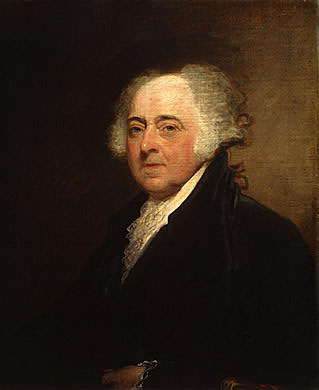Search This Blog
Thursday, January 5, 2012
John Adams
Served as president from 1797-1801
Era: The Early National Era
American Identity and Culture
Before the year 1800, the capitol of the United States was located in Philadelphia, Pennsylvania. During George Washington’s presidency, John Adam’s predecessor, congress passed an act known as the Residence Act of 1790 which declared Philadelphia as the temporary capitol for the United States until a new permanent capitol could be decided. The act was passed as a compromise for Alexander Hamilton, Thomas Jefferson, and James Madison because Jefferson and Madison wanted the capitol to be located somewhere in the South along the Potomac River, while Hamilton wanted the capitol to be located near the Potomac River in order to gain delegate votes to pass his Assumption Bill. Washington soon decided that the new capital would be located in Washington D.C.; however the construction of the new capital would be completed by December 1800. On June 11, 1800 the construction of the new capitol was finished and the new capital of the United States was officially located in Washington D.C. John Adams was the first president to reside in the White House also known as the Executive Mansion, however only stayed for a few months after losing his reelection to Jefferson. After John Adams, every president after him has resided in the White House.
Economic Transformation and Globalization
In 1793, Eli Whitney invented the cotton gin which improved the efficiency of planting and picking cotton. During the 1800s, the South’s economy was based on exporting their cash crops. The main export during the time was cotton, so with the new invention exports of cotton increased and more farmers began to look for fertile land to grow cotton on. Before Adam’s presidency, the main cash crops were tobacco and indigo. In need of more land, southerners often looked for land near Mississippi and Alabama. As southerners searched for more land to grow their cotton, they invested their money on buying new slaves to work in the cotton fields and saved money to export their cotton to foreign countries, such as, British textiles factories.
Environment
With farming becoming more and more popular because of the profitable business of cotton, farming was known to be a stable job to provide food and clothes for the family. In the west, large amounts of land were available for farming. The federal government offered the land to farmers at very low costs. State banks also provided farmer with loans at low rates to help farmers afford the cheap land. In the beginning, the western famers were only allowed to send their crops through the Mississippi and Ohio River to reach the southern markets. However with more canals being built, the farmers were allowed to send their crops to cities with factory markets growing in the east.
Politics and Citizenship
In the election of 1800, the Federalists had lost a huge amount of support and popularity. They lost power in both the legislative and executive branches of the U.S. government. People complained about having to pay new taxes enacted by the Federalists to fund the building of a stronger U.S. Navy and to prepare for a war against France, which in the ended never happened because John Adams pursued a peaceful method of negotiating with France. People also detested the Alien and Sedition Acts. Therefore, majority of the votes went to the Republicans Aaron Burr and Thomas Jefferson who ended up in a tie. As a result of both candidates receiving the same amount of votes, the House of Representatives decided to give the majority to Jefferson because they were convinced by Alexander Hamilton that Jefferson would make a better President than Burr who Hamilton claimed was dangerous. With Jefferson winning the election of 1800, it signaled the transfer of power from the Federalist Party to the Republican Party in a peaceful process.
Slavery and its legacies in North America
Before John Adams was elected president, he was vice president to George Washington. In 1755, John Adams proposed the Declaration of Independence. To gain support from Virginia, Adams selected Thomas Jefferson to write the first draft of the Declaration of Independence. While Jefferson wanted to include a no slavery clause, the Continental Congress did not want anything about slavery written in the constitution. Adams, on the other hand, had no position on slavery and only cared for the preservation of the Union with or without slavery.
After John Adams was elected into presidency, he did not interfere in any issues concerning slavery because of his position as President. Adams was forced to have a “blind eye” about the issues of slavery and tried to keep to his belief of preserving the Union. While his wife, Abigail Adams, was known to be a female abolitionist, she pressed for the abolition of slavery without the help of Adams.
War and Diplomacy
During Adams’ presidency, John Adams faced his first major obstacle which later becomes known as the XYZ affair. When news of U.S. trading ships being detained by French warships and privateers because of resentment from the French caused by the French Revolution reached the United States, Americans were angered. Fearing violence, Adams tried to settle this peacefully by sending delegates to Paris to compromise with the French government. The French ministers, whose identities were never exposed, were dubbed as X, Y, and Z. They demanded for bribes otherwise they would have no interest in compromising. The Americans anger now turned into rage wanting to go to war with France. One group of Federalists led by Alexander Hamilton urged for war in hopes of gaining Spanish and French territories in North America. However, John Adams still wanted to settle this dispute peacefully and sent new delegates to Paris to compromise.
Subscribe to:
Post Comments (Atom)

No comments:
Post a Comment